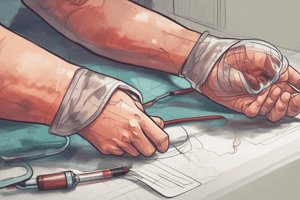Podcast
Questions and Answers
What is the angle of insertion for venipuncture?
What is the angle of insertion for venipuncture?
15 degrees
What is the antecubital space?
What is the antecubital space?
The surface of the arm in front of the elbow.
What is an anticoagulant?
What is an anticoagulant?
A substance that inhibits blood clotting.
What is the buffy coat?
What is the buffy coat?
Define an evacuated tube.
Define an evacuated tube.
What is a hematoma?
What is a hematoma?
What does hemoconcentration refer to?
What does hemoconcentration refer to?
What is hemolysis?
What is hemolysis?
Define osteochondritis.
Define osteochondritis.
What is osteomyelitis?
What is osteomyelitis?
Who is a phlebotomist?
Who is a phlebotomist?
What is phlebotomy?
What is phlebotomy?
What is plasma?
What is plasma?
What is serum?
What is serum?
Define venipuncture.
Define venipuncture.
What is venous reflux?
What is venous reflux?
What is venous stasis?
What is venous stasis?
List the 3 major areas of blood collection included in phlebotomy.
List the 3 major areas of blood collection included in phlebotomy.
What are unique identifiers on labels?
What are unique identifiers on labels?
Why is it important to reassure the patient?
Why is it important to reassure the patient?
What is the proper patient position for a blood draw?
What is the proper patient position for a blood draw?
Why does venous reflux happen and how is it prevented?
Why does venous reflux happen and how is it prevented?
What is the application of the tourniquet?
What is the application of the tourniquet?
Flashcards
Antecubital Space
Antecubital Space
The area in front of the elbow, a common site for venipuncture.
Anticoagulant
Anticoagulant
A substance that prevents blood from clotting.
Buffy Coat
Buffy Coat
Layer of white blood cells and platelets, found between plasma and red blood cells in a blood sample after anticoagulant use.
Evacuated Tube
Evacuated Tube
Signup and view all the flashcards
Hematoma
Hematoma
Signup and view all the flashcards
Hemoconcentration
Hemoconcentration
Signup and view all the flashcards
Hemolysis
Hemolysis
Signup and view all the flashcards
Phlebotomist
Phlebotomist
Signup and view all the flashcards
Phlebotomy
Phlebotomy
Signup and view all the flashcards
Plasma
Plasma
Signup and view all the flashcards
Serum
Serum
Signup and view all the flashcards
Venipuncture
Venipuncture
Signup and view all the flashcards
Venous Reflux
Venous Reflux
Signup and view all the flashcards
Venous Stasis
Venous Stasis
Signup and view all the flashcards
Osteochondritis
Osteochondritis
Signup and view all the flashcards
Osteomyelitis
Osteomyelitis
Signup and view all the flashcards
Unique Identifiers
Unique Identifiers
Signup and view all the flashcards
Needle Insertion Angle
Needle Insertion Angle
Signup and view all the flashcards
Tourniquet Application
Tourniquet Application
Signup and view all the flashcards
Ideal Arm Position
Ideal Arm Position
Signup and view all the flashcards
Patient Positioning Safety
Patient Positioning Safety
Signup and view all the flashcards
Patient Reassurance
Patient Reassurance
Signup and view all the flashcards
Study Notes
Venipuncture Techniques
- Needle insertion angle should be at 15 degrees; positioning is crucial for successful venipuncture.
- Angles less than 15 degrees can cause needle to enter above the vein, preventing proper puncture.
- Angles over 15 degrees risk puncturing the posterior wall of the vein, leading to hematoma.
Anatomical Considerations
- Antecubital space refers to the area in front of the elbow where venipuncture is commonly performed.
Key Terms in Phlebotomy
- Anticoagulant: Substance that inhibits blood clotting, important for blood sample preservation.
- Buffy coat: Layer of white blood cells and platelets between plasma and red blood cells after anticoagulant use.
- Evacuated tube: Pre-measured vacuum sealed glass or plastic tube used for blood collection.
- Hematoma: Swelling due to a mass of coagulated blood from a ruptured blood vessel.
- Hemoconcentration: Increased concentration of blood's non-filterable components due to reduced fluid content.
- Hemolysis: The breakdown of blood cells, which can impact sample quality.
Inflammation Conditions
- Osteochondritis: Inflammation of bone and cartilage.
- Osteomyelitis: Inflammation of bone or bone marrow due to bacterial infection.
Blood Collection Professionals
- Phlebotomist: Healthcare professional trained specifically for blood specimen collection.
Blood Component Details
- Phlebotomy: Procedure involving incision of a vein to collect blood.
- Plasma: Clear, straw-colored liquid making up about 55% of blood volume.
- Serum: Plasma with the clotting factor fibrinogen removed.
Blood Collection Processes
- Venipuncture: Technique of puncturing a vein for blood draw.
- Venous reflux: Backflow of blood from an evacuated tube into the patient’s vein, can cause adverse reactions.
- Venous stasis: Temporary slowing or cessation of venous blood flow.
Blood Collection Techniques
- Phlebotomy involves arterial puncture, venous puncture, and skin puncture for blood sample collection.
- Unique identifiers on labels include patient's full name and date of birth for accurate identification.
- Reassuring the patient before the procedure alleviates fears and helps in relaxing veins, making venipuncture easier.
Patient Positioning
- Ideal position for blood draw involves extending the arm downward, palm up, supported properly to prevent injury.
- Procedures should not be performed with the patient standing or on a stool to reduce fainting risks.
Tourniquet Use
- Applying a tourniquet makes veins more prominent for easier access while slowing venous blood flow.
- A tourniquet that is too tight may obstruct both venous and arterial blood flow, causing complications.
Studying That Suits You
Use AI to generate personalized quizzes and flashcards to suit your learning preferences.




